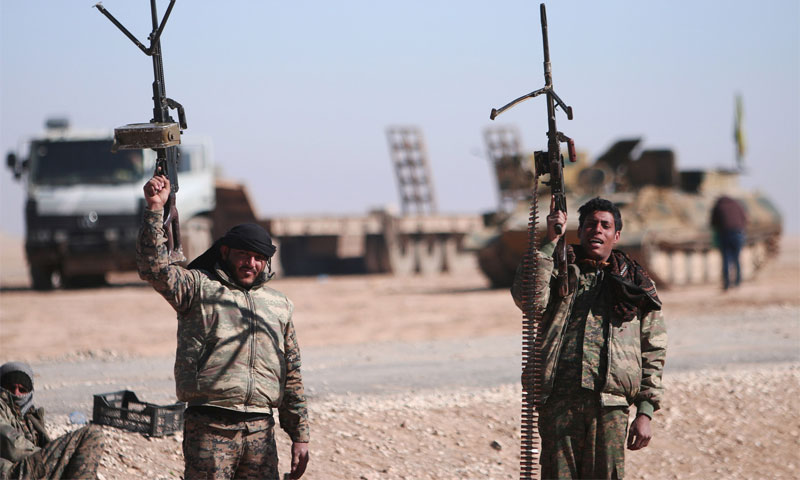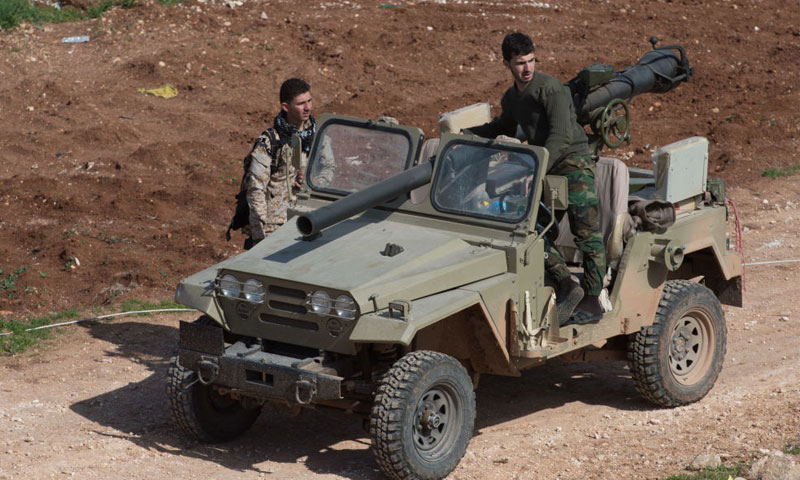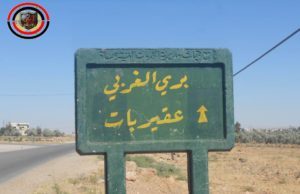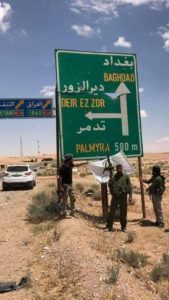The biggest loser in the “de-escalation zones” agreement adopted by Russia and Turkey last May between the opposition and the al-Assad regime in Syria is ISIS. The group has since faced a massive and unprecedented assault by al-Assad’s forces and foreign militias that are supported by Iran and backed by Russian airpower. The assault was concentrated on three fronts (al-Badia, the eastern countryside of Hama and the eastern countryside of Aleppo) and, naturally, aims to strike ISIS in the Syrian al-Badia and the eastern region.
The operations against ISIS by the regime and its allies are in line with continuing battles throughout the past six months in the group’s stronghold in Raqqa. The battles escalated in May and were led by the Syrian Democratic Forces, which are formed of an Arab-Kurdish coalition supported by the United States and the international coalition. The Syrian Democratic Forces are close to entering the city and striking ISIS in its main stronghold.
Three separate parties see a major interest in entering into the Deir ez-Zor province from its eastern front. The Iranian militias that support al-Assad, and which are welcomed by Russia, are pushing towards this area through their operations in al-Badia, along with operations by their Iraqi counterparts, the Popular Mobilization Forces. It is also one of the declared objectives of the Syrian Free Army factions in al-Badia that are near the Jordanian border, supported by the United States, the United Kingdom and Jordan. These factions do not hide their desire to advance towards Albu Kamal, while the Syrian Democratic Forces were the first to actually enter the province through its northern axis as part of Operation Euphrates Shield.
“De-escalation” agreement guides Syrian regime towards ISIS
On May 6, 2017, the countries sponsoring the International Meeting on a Syrian Settlement in Astana signed an agreement on setting up “de-escalation zones”. This directed the focus of the Syrian regime’s battles towards ISIS, despite the violations committed by its forces and the repeated conflicts and confrontations in some location, within areas controlled by the opposition.
According to the Russian Foreign Ministry, experts from Russia, Iran and Turkey will delineate the borders of the regions and establish barriers in these borders in order to prevent “armed men” from sneaking in. They will work in joint task forces “to study all the issues and determine who is responsible for ensuring security on the ground in Syria, as well as the demarcation of the external boundaries of the regions”.
Four districts witnessed relative calm in May, including Idlib, parts of the provinces of Aleppo, Hama, Latakia, the northern countryside of Homs, Eastern al-Ghouta and parts of the Daraa and Quneitra provinces in southern Syria.
A source in the Free Army in the countryside of Hama confirmed to Enab Baladi that Russian forces have placed barbed wire close to checkpoints controlled by al-Assad forces in the area of al-Mughayer in the northern countryside of Hama and other areas in the al-Ghab Plain in North-west Hama in May. He considered this step to be a “delineation of the de-escalation zones“.
However, fronts in the countryside of Hama, which were caught up in conflict a few months ago are now calm while the bombing of cities and towns in the region has significantly decreased. However, military factions there rejected “plans to partition Syria” and threatened to target any force that enters the region and demarcates new borders.
A statement was issued on May 26, in which military leaders from the al-Ghab Plain threatened to escalate fighting, in light of the continued construction of land barriers between villages. This was followed by another statement at the beginning of June, which rejected the drawing of borders. A leader in the Free Army told Enab Baladi, “If barriers are put up between us and our villages, and separation forces arrive, we will be prevented form liberating them. We completely reject this.”
Far from Hama, there is no fighting between the Syrian regime and the opposition in the countryside of Latakia and Aleppo. However, although al-Ghouta is included in the “de-escalation zones”, some of its southern areas witness frequent confrontations by local factions against the al-Assad forces.
Meanwhile, the regime is mobilizing its forces towards the city of Daraa, moving its fourth division to the area to confront opposition factions. These factions have confirmed their readiness to fight back, amid reports that the mobilization comes as part of a large-scale attack to regain certain locations in the al-Manshia district, in preparation for a take-over of the whole of Daraa.
The opposition was not satisfied with the recent decisions at the Astana summit, on the grounds that they were not linked to relevant UN resolutions, according to Osama Abu Zayd, the spokesman for its delegation at the negotiations. It also rejected Iran’s role in the agreement, “as it is a state that is hostile to the Syrian people”.
The delegation of opposition factions considers that any military or political decision or agreement about Syria “is invalid unless it emphasizes the need for a ceasefire, lifting the siege on besieged cities and towns, and releasing detainees”.
ISIS loses the fortress of al-Badia
Since its entry into Syria in mid-2013, ISIS has adopted a strategy of centralizing its presence in the Syrian desert, which it considered its natural stronghold after it was expelled by opposition factions from Idlib province, the northern countryside of Aleppo and the city of Aleppo and its northern countryside in early 2014. ISIS extended its presence from the Syrian desert to reach Raqqa, the eastern countryside of Aleppo and Deir ez-Zor towards Eastern al-Qalamoun and the eastern countryside of al-Suwayda. Thus, al-Badia was ISIS’s vital hub and the key to its survival.
The jihadi group continues to control the central mountain chain that extends from the city of al-Sukhnah to the region of al-Belaas in the Syrian Badia in the countryside of Homs. This strategic region is the launch point for its attacks towards Palmyra and the eastern countryside of Hama and Homs. However, last May, it lost all its positions in Palmyra’s mountains that extend from south of the city of Palmyra to the region of al-Dumeir.
On the ground, the regime and its Iranian and Russian allies have started to draw precise boundaries in the Syrian Badia after regaining the city of Palmyra from ISIS on March 2, starting from its various axes: from eastern Palmyra towards al-Sokhna, southern Palmyra, southeast of al-Qaryatayn, the eastern countryside of Damascus and the eastern countryside of al-Suwayda. They have made unprecedented progress against ISIS, especially in the month of May.
The battles against ISIS were concentrated in southeastern Homs. In addition, al-Assad’s forces and militias took control of various mountain ranges in the Syrian desert. During the last few days, they achieved considerable progress by regaining control over the villages and towns of al-Bardeh, al-Bassiri, Khunayfis, al-Elyaniya, and the strategic al-Muhasah mountain, which overlooks al-Qaryatayn from the southern axis. They subsequently took over the most important phosphate field in Syria, for which Tehran had signed an investment contract at the beginning of this year.
An account belonging to the “war media” associated with the Syrian regime and Iran confirmed that al-Assad forces and allied foreign militias took control of around 1,300 square kilometres of the Syrian desert in a matter of a few days. They now control the entire area stretching from Damascus to Palmyra. This operation is considered the largest of its kind against ISIS in Syria since 2011, confirming that the “Syrian army and its allies have destroyed the offensive and defensive capabilities of ISIS in central and south-eastern Syria”.
Prior to May and the “de-escalation zones” agreement from which the regime has benefited, ISIS had lost all its positions in the desert around Damascus and al-Suwayda, withdrawing after attacks by the opposition and al-Assad forces alike. ISIS forces are now centred in the Syrian desert in the eastern countryside of Homs, starting from the countryside of Palmyra to Deir ez-Zor.
Uqayribat.. A vital battle for al-Assad
Uqayribat in the eastern countryside of Hama has been controlled by ISIS since 2014. This area cannot be separated from the Syrian desert as they are similar in terms of desert elevations. Uqayribat is located deep inside Syria, extending from the eastern countryside of the city of al-Salamiyah reaching the administrative borders of the province of Raqqa. It is adjacent to al-Belaas, which is also controlled by ISIS in the countryside of Homs from the southern axis. Its most prominent towns and villages are Uqayribat, Suha, Abu Dali, Jruh, Salba, Abu Hanaya, Messaoud and Akash.
Uqayribat has been the launching point for ISIS attacks on villages in al-Salamiyah since 2014. The bloodiest attack was on the village of al-Mabuja in April 2015, where 60 people were killed and dozens wounded, as well as many being taken as prisoners and going missing. The incident was repeated two years later on May 18, when ISIS attacked the village of Aqarib, carrying out a massacre that took the lives of around 60 people, including civilians and members of the regime’s militias.
Al-Assad forces and foreign militias succeeded in making rapid progress against ISIS in the desert of Homs all the way up to the countryside of eastern Damascus. However, this operation will not be entirely successful if it does not include Uqayribat in the eastern countryside of Hama because of its strategic importance and geographical position next to the areas controlled by ISIS in Aleppo, Raqqa and Homs. On May 31, these forces launched ground and air attacks on Uqayribat, which it appears will face a fight to the death from ISIS.
Foreign and local militias are taking part in the assault, most notably the Lebanese Hezbollah, the Dar al-Qalamoun militia and Quwwat al-Nimr led by Commander Suheil al-Hassan. The assault started from the village of al-Barghouthiyya next to al-Belaas Mountains, which is also controlled by ISIS, in the eastern countryside of Homs. However, the attack has not lead to any advances so far, which is a clear indication of the fierceness of the battle and its difficulty for the regime, especially as it targets the last refuge for ISIS in the Syrian desert.
The Regime retreats to its last stronghold in Eastern Aleppo
Military developments in eastern Aleppo are occurring rapidly in conjunction with the “de-escalation zones” agreement, as part of moves by the al-Assad forces to impose military dominance over the eastern part of the province and expand their areas of influence in order to control the region and impose their military weight on the other military actors.
The al-Assad forces have enforced a large area of control from the Jirah Military Airbase (Keshish), the number one defensive fortress for ISIS, which the regime took over in mid-May after asserting full control over the surrounding villages and areas including the “strategic” town of Dayr Hafir. The al-Assad forces relied on Russian airpower, which accompanied all of their movements in the region.
After taking over the airport, al-Assad’s forces have accelerated their movements in the region on three military fronts. Each day, control was declared over villages, farms and small hills south of the airport, reaching the outskirts of the city of Maskanah, ISIS’ last stronghold in the countryside of Aleppo.
According to the war map, the al-Assad forces are currently imposing a siege and military crackdown on ISIS in the city from three fronts (south, west and north) after blocking the main Raqqa-Aleppo road. Regime forces are trying to connect this military front with the Khasir area in the southern countryside of Aleppo where it has launched similar military confrontations.
Al-Assad’s military operations in the region depend on foreign and local militias, most notably Quwwat al-Nimr (the Tiger Forces), which are under the direct command of Brigadier Suheil al-Hassan, one of the most prominent officers in al-Assad’s forces. This militia includes volunteers mainly from the provinces of Latakia and Tartus on the Syrian coast as well as volunteers from the countryside of Homs and Hama.
At the beginning of this year, al-Khafsah was the start point for al-Assad’s military incursion into the region after launching a battle directly supported by the Russians. This coincided with the expansion of the Free Army factions participating in Operation Euphrates Shield in the region, taking control of al-Bab. These factions attempted to expand south until they were confronted with the Russian-Turkish separation line in the village of Tadef.
The al-Assad forces seek to take control of the water station on the Euphrates River so they can once again transport water to Aleppo and to secure their large military zones such as the Quiris Military Airbase, the main base for managing their battles against ISIS.
The Syrian Democratic Forces entering the “Capital of the Caliphate”
The battle of Raqqa, led by the Syrian Democratic Forces (SDF) has recently entered into a new phase, contradicting all American expectations and statements about the time required for gaining control of Raqqa and the military steps to be taken against ISIS in its main stronghold. The latest of these was a statement by SDF leader Rojda Felat who said that “the battle of Raqqa will start next summer”.
The “de-escalation zones” agreement cannot be linked with the latest on-the-ground developments in the military confrontations in the city, considering the military steps and phases drawn up by SDF and the international alliance starting in November 2016, which are being followed according to a specific timeline.
However, these confrontations are considered one of the most important military operations in which the participating sides and the sponsors are trying to break the basis of ISIS’ “hegemony” in Syria, which has been the source of its first military activities and campaigns and the “Capital of the Caliphate”. Asserting control over this stronghold could lead to successive withdrawals from the remaining areas on Syrian territory.
As part of the fourth phase of Operation Euphrates Anger launched on April 14, SDF has made significant progress against ISIS on all military fronts surrounding Raqqa (to the north, west and east). This phase has seen a drastically different type of progress from the previous phases whether in terms of the military tactics adopted or the target areas.
Apart from the military support in the shape of weapons and ammunitions provided by the United States Department of Defence (the Pentagon), SDF announced in the past few days in conjunction with the significant military achievements that it has begun delivering light weapons and arms to “Kurdish forces” as part of the battle against ISIS in Raqqa.
According to the war map of control, and other than the SDF, which has imposed a media blackout in the current military phase, the Operation Euphrates Anger fighters arrived at the boundaries of the neighborhood of al-Mashbal, northeast of the city of Raqqa and took control of large parts of it. This was after it had taken control of dozens of villages surrounding it, such as al-Salhia and al-Assadia, as well as the local sugar factory and cotton industrial complex.
The international alliance forces announced that the Syrian Democratic Forces had tightened their grip on ISIS, noting that they had advanced and taken control of around 350 square kilometers of its positions north and east of Raqqa in the space of one week.
Military operations are not limited to the eastern front. The Syrian Democratic Forces have established other fronts against the Islamic State in the western part of the city. Through these fronts, they were able to take over strategic areas, especially after taking full control of the city of al-Tabqah in the western , from which ISIS was expelled a few days before the de-escalation agreement was declared.
It took control of the al-Baath Dam northwest of Raqqa on May 26, after the Islamic State was pushed out of the village of Kediran, its north-western gateway. It is considered the third largest dam in Syria, located between the cities of al-Tabqah and Raqqa and 27 km away from the Euphrates Dam, over which it also recently gained control.
It also expanded its area of control to the strategic town of al-Mansoura adjacent to the al-Baath Dam (“Freedom Dam”, as the SDF calls it), which is 20 kilometers from the city of al-Tabqah.
Sources told Enab Baladi that SDF took control of the control of the town after the withdrawal of the Islamic State under an agreement with the SDF, under which ISIS was allowed to leave the town and head to the areas under its control in the eastern countryside of Homs. This was criticized by Russia, which accused the SDF of reaching an agreement with the Islamic State to evacuate the city of Raqqa and its surroundings towards the Syrian Desert. Russia said that it had strong evidence to support its allegations, including video recordings.
The Kurdish People’s Protection Units are considered to be the biggest force within the Syrian Democratic Forces. Arab factions have also joined it, most notably the Deir ez-Zor Military Council and the Elite Forces of the Syria Tomorrow Movement founded by opposition activist Ahmad al-Jarba.
Flames of war reach Deir ez-Zor
Various forces are racing to take over Deir ez-Zor and include it within their areas of control. The biggest and most prominent operation against the Islamic State in May was that of the Iraqi Popular Mobilization Forces, which moved the fighting to the border and began advancing towards Syria from the eastern side of Tal Afar in Iraq and to the southeast of Albu Kamal in Syria.
“Al-Hashd al-Shaabi (Popular Mobilization Forces) was founded in June 2014, based on fatwas (formal legal opinions concerning Islamic law) by Iraqi Shiite religious authorities. It consists of 67 Shiite factions close to Tehran as well as various militias, notably Harakat Hezbollah al-Nujaba, which is fighting alongside the al-Assad forces against the Syrian opposition.”
Alongside the Popular Mobilization Forces, al-Assad’s forces, part of which are located in the city of Deir ez-Zor, are participating in the race to take control of the city. The Syrian Democratic Forces are also targeting the city after advancing from the northwest. The chances of the opposition appear to be very slim, despite having entered within the administrative borders of the province from the southern front as part of recent battles in the countryside.
At the beginning of last May, the Iraqi Popular Mobilization Forces sought to get closer to the Syrian border following its reassertion of control over al-Hadar in Iraq, which is a key communications hub between Mosul and Syria to the west and Anbar province in the south, and to al-Furat province in the border town of al-Qaim.
The Popular Mobilization Forces demonstrated their intention to advance towards the Syrian border through accelerated battles, which enabled it to gain control of the area of al-Qayrawan near the Syrian border (west of Mosul and Tal Afar) as of Saturday June 3. This came after battles against ISIS, which began under the name “Muhammad Rasoolullah” on May 12.
Gaining control of al-Qayrawan on May 23 opened a direct line to Syria and allowed the Popular Mobilization Forces to intensify their operations in order to control the most important of ISIS’ supply lines towards Mosul and secure the borders. However, this will be difficult as ISIS is able to exploit valleys, tunnels and other areas to cross the border, according to military experts.
The Popular Mobilization Forces have moved towards al-Qaim city in Anbar province, in western Iraq, which is under ISIS control. They are aiming to reach the nearby Syrian city of Albu Kamal, which is part of Deir ez-Zor province, through their forces stationed in the border village of Umm Jrees.
This is considered the first military move by the Iraqi militia on the Syrian border. Its operations against the Islamic State during the past months have focused on the surrounding area and to the south of the Iraqi city of Mosul.
The Popular Mobilization Forces’ battles continue in parallel with military operations by the al-Assad forces against opposition factions west of Albu Kamal. Although both sides remain far from the eastern countryside of Deir ez-Zor, the battles in the Syrian Badia near the al–Tanf border crossing suggest radical changes may occur in the region in the near future.
Free Army factions have advanced as part of the “Sarajna al-Jiyad Li tatthiri al-Hamad” battle (in Arabic, “we have mounted our horses to cleanse al-Hamad”) against ISIS in recent months. The factions reached Fayyad al-Hamad, the closest point to Albu Kamal, but stopped since then in light of the battles initiated by al-Assad forces south-west of the area, around 27 kilometers from the al-Tanf crossing.
The al-Assad forces managed to gain control of the area of al-Zarqa after crossing Muthalath al-Badia (the “Desert Triangle”) linking the roads to Baghdad, Jordan and Damascus. This gave them the chance to advance towards Albu Kamal in addition to their battles against ISIS east of Palmyra. They are advancing to al-Sukhnah, which is controlled by ISIS, and which is located on the main road towards the city of Deir ez-Zor.
The US-backed Syrian Democratic Forces entered the administrative boundaries of Deir ez-Zor months ago from the northwestern front as part of the group’s operations to isolate ISIS in the city of Raqqa. Although its progress has been suspended since then, it plans to complete its progress toward Deir ez- Zor.
The group is advancing while waging battles towards Raqqa in order to seize the largest part of the northern area of Deir ez-Zor on the map, according to Riyad Derar, a resident of Deir ez-Zor and the joint chairman of the Democratic Council of Syria. He told Enab Baladi, after his election last February, that Deir ez-Zor is the second stage after the “liberation of Raqqa”.
However, military analysts rule out the entry of these forces as a vanguard in battles, because they are preoccupied with the battle for Raqqa, which is expected to turn into a long war of attrition, and due to Arab-Kurdish sensitivities in the region.
The opposition remains the least likely to reach Deir ez-Zor, as it is far from the eastern countryside of the province (Hajin and al-Shaaitat), around 60 kilometers south. This is despite the fact that it is supported by US and British forces stationed at the al-Tanf base.
Deir ez-Zor is seen as a “major” strategic prize, as it gives any force that controls it a tight grip on the eastern region of Syria, access to an “enormous” oil wealth and the ability to consolidate its areas of control on the Tehran-Damascus axis.
if you think the article contain wrong information or you have additional details Send Correction
النسخة العربية من المقال
-
Follow us :
Most viewed
- Printing Syrian currency in Europe... A file on the table
- Complex steps to establish new Syrian army
- National Security Council in Syria: A necessity imposed by reality
- SDF-Damascus agreement in Aleppo: A test balloon for broader consensus
- Al-Sharaa appoints Abdul Qader Hasriyeh as Governor of Central Bank


















 A
A
A
A
A
A












 More In-Depth
More In-Depth